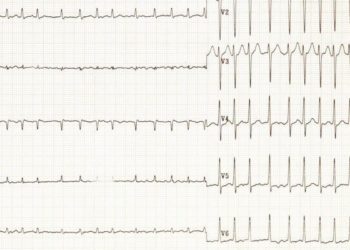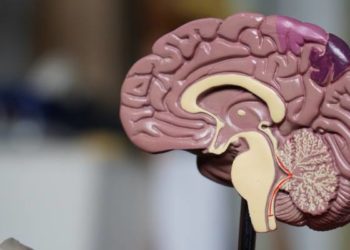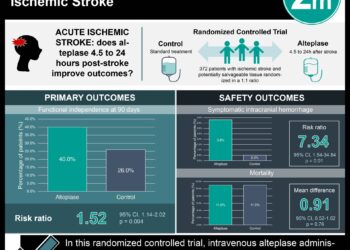Rates of recurrent ischemic stroke among young adults with prior embolic stroke of undetermined source– the Young ESUS longitudinal cohort study
1. In patients with prior history of embolic stroke of undetermined source, there was a relatively low rate of subsequent ischemic stroke and new-onset atrial fibrillation compared to older patients.
2. Most recurrent strokes also met criteria for embolic stroke of undetermined source, suggesting future studies are needed to improve understanding of the underlying pathophysiology of ischemic stroke in this vulnerable population.
Evidence Rating Level: 2 (Good)
Study Rundown: Approximately 40% of ischemic strokes in young adults have no evidence of lacunar infarct or any identifiable source of embolism and is referred to as cryptogenic stroke or embolic stroke of undetermined source (ESUS). The clinical construct behind ESUS was evaluated in 2 landmark randomized clinical trials, NAVIGATE ESUS and RESPECT ESUS, where a high rate of recurrent stroke in older adults with prior ESUS was observed. However, the prognosis and prognostic factors for stroke recurrence in this patient population has not been studied. This longitudinal cohort study characterized the clinical features of young patients with ESUS and determined the subtype of the recurrent stroke and rates of ischemic stroke recurrence, mortality, and atrial fibrillation (AF) during a follow-up period of up to 18 months. The main outcomes were rates of recurrent ischemic stroke and/or mortality, recurrent ischemic stroke, and prevalence of patent foramen ovale (PFO). Among 535 patients with prior history of ESUS, there was a relatively low rate of subsequent ischemic stroke (1.9 per 100 patient-years) and new onset AF (2.8%) compared to older patients with ESUS at follow-up. Risk factors associated with stroke recurrence included a history of stroke or transient ischemic attack (TIA), diabetes, and coronary artery disease (CAD). Additionally, most recurrent strokes met criteria for ESUS, suggesting future studies are needed to improve understanding of the underlying pathophysiology of ischemic stroke in this vulnerable population. A limitation of this study was that only tertiary research centers with a high-volume of stroke were included which may not accurately reflect the spectrum of disease and institutional resources and expertise at other centers.
Click to read the study in JAMA Neurology
Click to read an accompanying editorial in JAMA Neurology
Relevant Reading: Frequency and features of embolic stroke of undetermined source in young adults
In-Depth [prospective cohort]: This multicenter longitudinal cohort study included 535 patients (mean [SD] age, 40.4 [7.3] years; 297 [56%] male) ≤50 years with ESUS. The study was conducted at 41 centers across 13 countries between October 2017 to October 2019. The most common vascular risk factors in the study cohort were tobacco use (45%), hypertension (22%), and dyslipidemia (20%). In patients who received a transthoracic echocardiogram, PFO was detected in 177 (50%). Following initial ESUS, 468 (88%) patients were put on antiplatelet therapy and 52 (10%) on anticoagulation. Overall, the rate of recurrent ischemic stroke and mortality was 2.19 per 100 patient-years and the ischemic stroke recurrence rate was 1.9 per 100 patient-years. In patients who suffered a recurrent stroke, 9 (64%) were ESUS, 2 (14%) were cardioembolic, and 3 (21%) were of other known causes. Additionally, AF was detected in 15 patients (2.8%; 95%CI, 1.6-4.6). In multivariate analysis, history of stroke or TIA (HR, 5.3; 95%CI, 1.8-15), presence of diabetes (HR, 4.4; 95%CI, 1.5-13), and history of CAD (HR, 10; 95%CI, 4.8-22) were associated with recurrent ischemic stroke.
Image: PD
©2022 2 Minute Medicine, Inc. All rights reserved. No works may be reproduced without expressed written consent from 2 Minute Medicine, Inc. Inquire about licensing here. No article should be construed as medical advice and is not intended as such by the authors or by 2 Minute Medicine, Inc.









